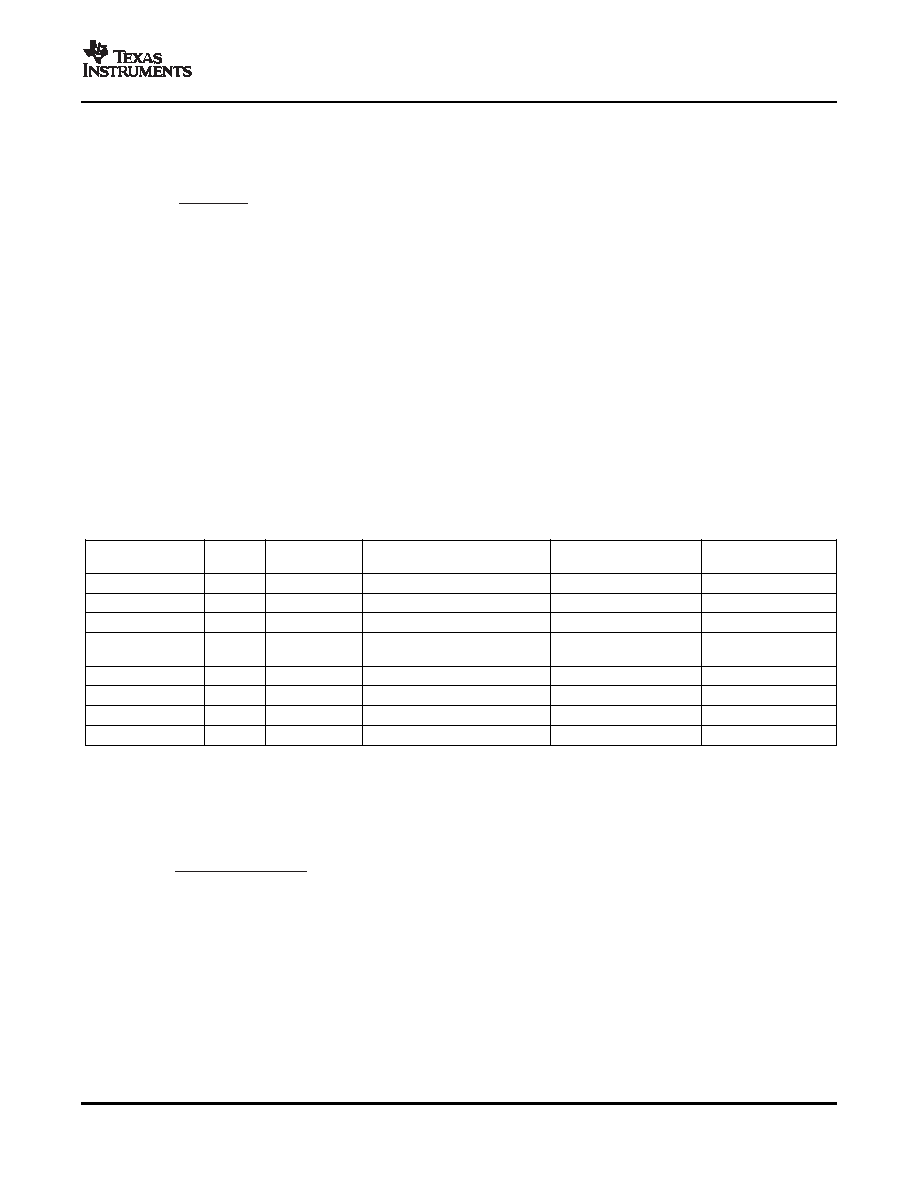- 您現(xiàn)在的位置:買賣IC網(wǎng) > PDF目錄98284 > TPS61080DRCTG4 (TEXAS INSTRUMENTS INC) 0.5 A SWITCHING REGULATOR, 1500 kHz SWITCHING FREQ-MAX, PDSO10 PDF資料下載
參數(shù)資料
| 型號: | TPS61080DRCTG4 |
| 廠商: | TEXAS INSTRUMENTS INC |
| 元件分類: | 穩(wěn)壓器 |
| 英文描述: | 0.5 A SWITCHING REGULATOR, 1500 kHz SWITCHING FREQ-MAX, PDSO10 |
| 封裝: | 3 X 3 MM, 1 MM HEIGHT, GREEN, PLASTIC, QFN-10 |
| 文件頁數(shù): | 7/25頁 |
| 文件大?。?/td> | 925K |
| 代理商: | TPS61080DRCTG4 |

www.ti.com
I
L_DC +
Vout
Iout
V
in
h
(12)
INPUT AND OUTPUT CAPACITOR SELECTION
Cout +
Vout * Vin Iout
Vout
Fs
V
ripple
(13)
V
ripple_ESR + Iout
R
ESR
(14)
SLVS644B – FEBRUARY 2006 – REVISED JANUARY 2007
The inductor's inductance value determines the inductor ripple current. It is generally recommended to set peak
to peak ripple current given by Equation 4 to 30–40% of DC current. Also, the inductor value should not be
beyond the range in the recommended operating conditions table. It is a good compromise of power losses and
inductor size. Inductor DC current can be calculated as
The internal loop compensation for PWM control is optimized for the external component shown in the typical
application circuit with consideration of component tolerance. Inductor values can have
±20% tolerance with no
current bias. When the inductor current approaches saturation level, its inductance can decrease 20% to 35%
from the 0A value depending on how the inductor vendor defines saturation current. Using an inductor with a
smaller inductance value forces discontinuous PWM in which inductor current ramps down to zero before the
end of each switching cycle. It reduces the boost converter’s maximum output current, causes large input
voltage ripple and reduces efficiency. An inductor with larger inductance reduces the gain and phase margin of
the feedback loop, possibly resulting in instability.
For these reasons, 10
H inductors are recommended for TPS61080 and 4.7H inductors for TPS61081 for most
applications. However, 10
H inductor is also suitable for 600kHz switching frequency.
Regulator efficiency is dependent on the resistance of its high current path and switching losses associated with
the PWM switch and power diode. Although the TPS61080/1 has optimized the internal switches, the overall
efficiency still relies on inductor’s DC resistance (DCR); Lower DCR improves efficiency. However, there is a
trade off between DCR and inductor size, and shielded inductors typically have higher DCR than unshielded
ones. Table 3 list recommended inductor models.
Table 3. Recommended Inductor for TPS61080/1
TPS61080
L
DCR MAX
SATURATION CURRENT
Size
VENDOR
(
H)
(m
)
(A)
(L
×W×H mm)
VLCF4018T
10
188
0.74
4.0
× 4.0 × 1.8
TDK
CDRH4D16NP
10
118
0.96
4.0
× 4.0 × 1.8
Sumida
LQH43CN100K
10
240
0.65
4.5
× 3.6 × 2.6
Murata
TPS61081
L
DCR MAX
SATURATION CURRENT
Size
VENDOR
(
H)
(m
)
(A)
(L
×W×H mm)
VLCF5020T
4.7
122
1.74
5.0
× 5.0 × 2.0
TDK
VLCF5014A
6.8
190
1.4
5.0
× 5.0 × 1.4
TDK
CDRH4D14/HP
4.7
140
1.4
4.8
× 4.8 × 1.5
Sumida
CDRH4D22/HP
10
144
1.5
5.0
× 5.0 × 2.4
Sumida
The output capacitor is mainly selected to meet output ripple and loop stability requirements. This ripple voltage
is related to the capacitor’s capacitance and its equivalent series resistance (ESR). Assuming a capacitor with
zero ESR, the minimum capacitance needed for a given ripple can be calculated by
Vripple = Peak to peak output ripple.
For VIN = 3.6V, Vout = 20V, and Fs = 1.2MHz, 0.1% ripple (20mV) would require 1.0
capacitor, however, the
minimum recommended output capacitor for control loop stability is 4.7
F. For this value, ceramic capacitors
are a good choice for its size, cost and availability.
The additional output ripple component caused by ESR is calculated using:
Due to its low ESR, Vripple_ESR can be neglected for ceramic capacitors, but must be considered if tantalum or
electrolytic capacitors are used.
15
相關(guān)PDF資料 |
PDF描述 |
|---|---|
| TPS61093DSK | 1.5 A SWITCHING REGULATOR, 1400 kHz SWITCHING FREQ-MAX, PDSO10 |
| TPS61122PWRG4 | 1.6 A BATTERY CHARGE CONTROLLER, 600 kHz SWITCHING FREQ-MAX, PDSO16 |
| TPS61131PWG4 | 1.6 A BATTERY CHARGE CONTROLLER, 600 kHz SWITCHING FREQ-MAX, PDSO16 |
| TPS61221DCKR | 0.4 A BATTERY CHARGE CONTROLLER, PDSO6 |
| TPS61251DSGT | SWITCHING REGULATOR, 3500 kHz SWITCHING FREQ-MAX, PDSO8 |
相關(guān)代理商/技術(shù)參數(shù) |
參數(shù)描述 |
|---|---|
| TPS61080EVM-147 | 功能描述:電源管理IC開發(fā)工具 TPS61080-147 Eval Mod RoHS:否 制造商:Maxim Integrated 產(chǎn)品:Evaluation Kits 類型:Battery Management 工具用于評估:MAX17710GB 輸入電壓: 輸出電壓:1.8 V |
| TPS61081 | 制造商:TI 制造商全稱:Texas Instruments 功能描述:HIGH VOLTAGE DC/DC BOOST CONVERTER WITH 0.5-A/1.3-A INTEGRATED SWITCH |
| TPS61081DRCR | 功能描述:LED照明驅(qū)動器 High Vge DC/DC Boost Converter RoHS:否 制造商:STMicroelectronics 輸入電壓:11.5 V to 23 V 工作頻率: 最大電源電流:1.7 mA 輸出電流: 最大工作溫度: 安裝風格:SMD/SMT 封裝 / 箱體:SO-16N |
| TPS61081DRCRG4 | 功能描述:LED照明驅(qū)動器 27V 1.2A SW 1.2MHz Boost Cnvrtr RoHS:否 制造商:STMicroelectronics 輸入電壓:11.5 V to 23 V 工作頻率: 最大電源電流:1.7 mA 輸出電流: 最大工作溫度: 安裝風格:SMD/SMT 封裝 / 箱體:SO-16N |
| TPS61081DRCT | 功能描述:LED照明驅(qū)動器 High Vge DC/DC Boost Converter RoHS:否 制造商:STMicroelectronics 輸入電壓:11.5 V to 23 V 工作頻率: 最大電源電流:1.7 mA 輸出電流: 最大工作溫度: 安裝風格:SMD/SMT 封裝 / 箱體:SO-16N |
發(fā)布緊急采購,3分鐘左右您將得到回復。